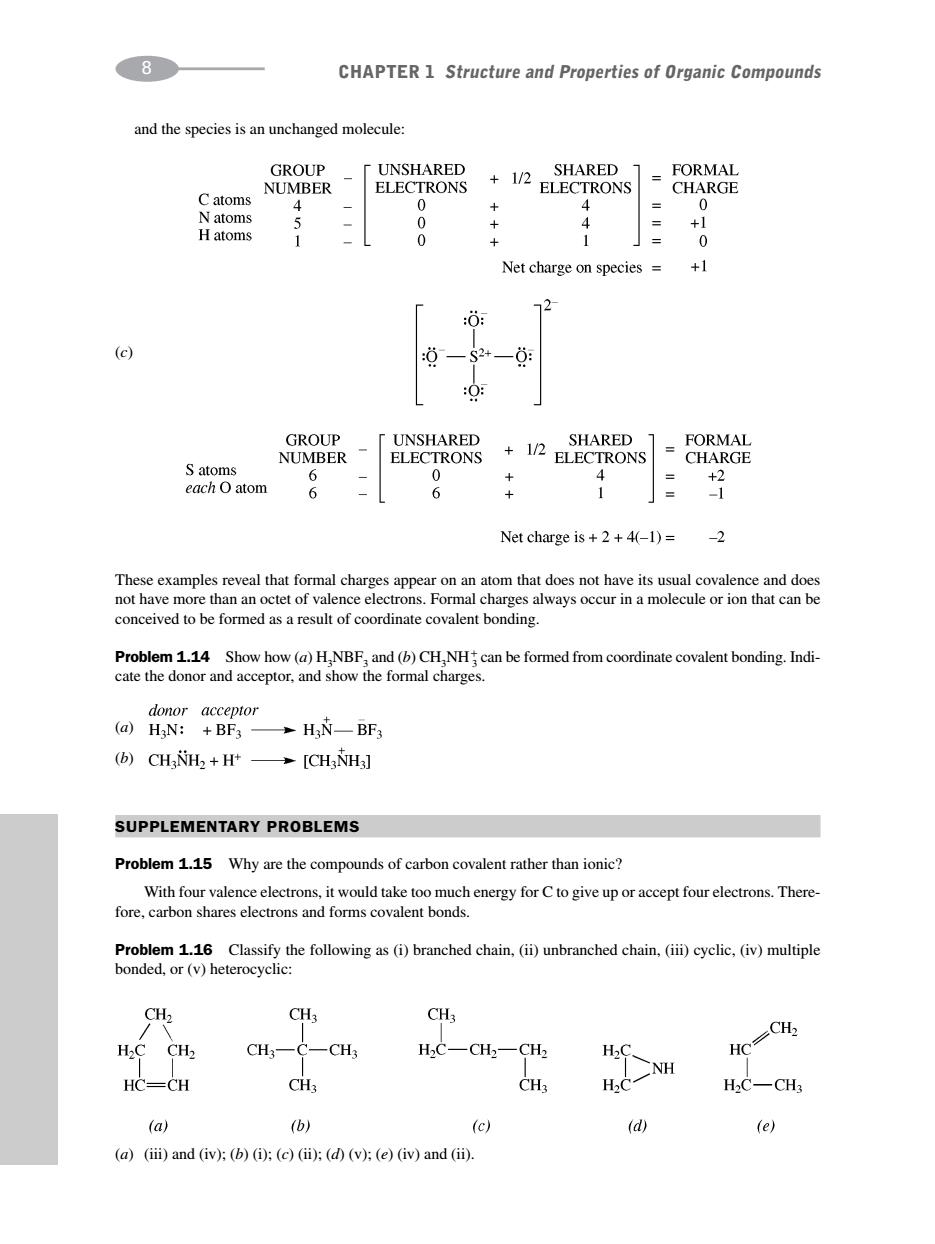正在加载图片...

8 CHAPTER 1 Structure and Properties of Organic Compounds and the species is an unchanged molecule: GROUP UNSHARED sHared +1/2 FORMAL NUMBER ELECTRONS ELECTRONS CHARGE Catoms 4 0 A 0 N atoms 0 4 +1 H atoms 1 0 0 Net charge on species +1 0: (c) :0一S2+0: 可 GROUP T UNSHARED +1/2 SHARED FORMAL NUMBER ELECTRONS ELECTRONS CHARGE S atoms 6 0 4 +2 each O atom 6 6 1 -1 Net charge is+2+4(-1)= These examples reveal that formal charges appear on an atom that does not have its usual covalence and does not have more than an octet of valence electrons.Formal charges always occur in a molecule or ion that can be conceived to be formed as a result of coordinate covalent bonding Problem 1.14 Show how(a)H,NBF,and(b)CH,NH can be formed from coordinate covalent bonding.Indi cate the donor and acceptor,and show the formal charges. donor acceptor (@HN:+BF3→H,N-BF (b)CH2NH2+H+ [CH3NH3] SUPPLEMENTARY PROBLEMS Problem 1.15 Why are the compounds of carbon covalent rather than ionic? With four valence electrons,it would take too much energy for C to give up or accept four electrons.There fore,carbon shares electrons and forms covalent bonds. Problem 1.16 Classify the following as(i)branched chain,(ii)unbranched chain,(iii)cyclic,(iv)multiple bonded,or(v)heterocyclic CH2 CH3 CH3 CH2 CH3一C一CH H2C-CH2一CH2 HC. HC NH HC=CH CH3 HC一CH (a) (b) (c) (e (a)(iii)and (iv);(b)(i);(c)(ii);(d)(v);(e)(iv)and (ii). and the species is an unchanged molecule: 8 CHAPTER 1 Structure and Properties of Organic Compounds These examples reveal that formal charges appear on an atom that does not have its usual covalence and does not have more than an octet of valence electrons. Formal charges always occur in a molecule or ion that can be conceived to be formed as a result of coordinate covalent bonding. Problem 1.14 Show how (a) H3 NBF3 and (b) CH3 NH 3 can be formed from coordinate covalent bonding. Indicate the donor and acceptor, and show the formal charges. SUPPLEMENTARY PROBLEMS Problem 1.15 Why are the compounds of carbon covalent rather than ionic? With four valence electrons, it would take too much energy for C to give up or accept four electrons. Therefore, carbon shares electrons and forms covalent bonds. Problem 1.16 Classify the following as (i) branched chain, (ii) unbranched chain, (iii) cyclic, (iv) multiple bonded, or (v) heterocyclic: (a) (b) (c) (a) (iii) and (iv); (b) (i); (c) (ii); (d) (v); (e) (iv) and (ii)